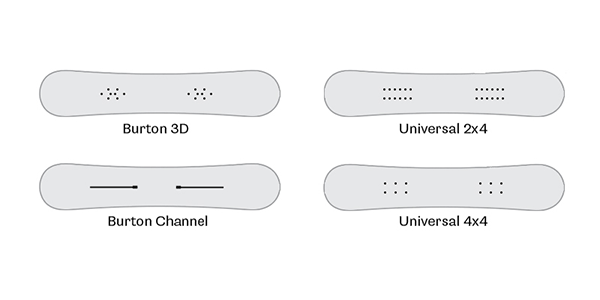SNOWBOARD BINDINGS: HOW TO PICK THE RIGHT FLEX

Article by Katlyn Krebs
You have the boots, and you have the board, but now you need the binding. Every snowboarder goes through this dilemma. Whether it's your very first set up or you're adding another to the quiver, choosing a new binding can be confusing. So let's clear things up.
The first step to finding the perfect flexing binding is to determine the type of binding mounts. There are four types of binding mounts: 3D, Channel, Universale 2x4, and Universal 4x4. 3D and Channel are mounting systems developed by Burton. Channel and Universal 2x4 replaced 3D. Universal 2x4 and Universal 4x4 are seen across many brands of snowboards.

Now that binding mounts have been identified, its time to identify what size binding you need. Binding sizes will vary slightly from brand to brand; however, companies provide a sizing chart to determine the correct size. The tip of the sole should line up with the end of the base plate of the binding. Some toe overhang is okay, but too much can cause the toe of your boot to drag.
Once your binding size is determined, its time to assess your skill level. Is this your first time snowboarding? Or are you a seasoned veteran? In most cases, new snowboarders should start with a soft flexing binding to allow the most forgiveness when learning fundamental edge control. In contrast, an experienced snowboarder may lean towards a stiff binding for instant response and control. Bindings flex ranges on a scale of 1 to 10, one being the softest and ten being the stiffest. When deciding your skill level, keep in mind your speed. Are you inching down the bunny hill or flying at the speed of light? A stiff binding provides quick response and control, whereas a soft binding is more forgiving or slow in its response.
After your skill level has been determined, where do you like to ride? Are you winding through trees, or are you exclusively in the park? Park riders usually lean towards a softer setup allowing them to press and flex their boards as needed. A rider that enjoys quick and aggressive turns may choose a stiff binding for optimal control. Other riders will ride all over the hill. For these riders, a medium flex binding provides flex and forgiveness and response and control.
Lastly, consider the flex and behavior of your snowboard of choice. If your board lacks response or control, consider a medium to the stiff binding. If your board is responsive but lacks forgiveness and flex, consider a soft to medium flex binding.
When determining the flex of your binding, many factors contribute to your decision. Ultimately binding flex is up to you; choose the flex that will benefit your riding style.




